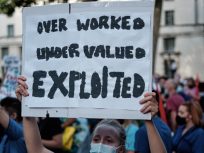
“Gherao is the expression of the popular movement. When we talk about gherao, we talk about people’s power. When we talk about gherao, we talk about the empowerment of workers and the marginalized section of our society and students who want a better future for them and the polity. That is why it is important to study the gherao movement.”
“Law is not independent. Law is the reflection of the society. When the people’s movement, when the people’s expression in a radical fashion is expressed, then law is changed according. ”
Interview of Human Rights Lawyer Adilur Rahman Khan on gherao
During an interview with a garment worker now organizer, I asked him how he came to labor organizing. He described an incident at one of the factories where he worked when the owner did not pay the workers wages, and he along with other workers decided to take over the factory establishment, and surround the owner until their wages were paid. This action, and the ability of workers collectively to redress their demands inspired him to be a organizer. His description reminded me of a tactic called gherao I had read about in South Asian labor history, and which is still used today but not to the extent that it was used in the 60s.
Literally meaning to encircle or surround, gherao is a more militant tactic used by workers and other social movement participants including students to seek compliance when law enforcement mechanisms fail or where employer fails to meet their legal obligations. It is illegal because it may involve wrongful confinement of the employer or taking over the owner’s factory. In the past, given public sympathy for workers, while the tactic was illegal, it found public support. Through gherao, philosophically, workers seeks to illustrate to owners the way in which they are surrounded and oppressed by working conditions and laws.
Gherao is often maligned as being violent, but that is not always the case. It is no doubt a more militant form of protest as compared to civil disobedience, human chains, or sit-ins. That gherao is used by workers when the law failed them shows it was primarily a tool for self-help. It is easy to blame workers who are forced to resort to this technique, where our attention should be on our legal system that fails to enforce labor laws.
Recently, workers used gherao to obtain wages owed from an employer who closed his factories and attempted to leave Bangladesh. Workers found the employer at the airport, and confined him in his factory for three days until he paid the wages. Had they not used this tactic, the employer would have fled the country and the workers would have lost their earned wages. This example shows that gherao can be a useful movement tactic to meet short term demands, and to provoke the system to address broader gaps in the laws which can led to long term changes in the law. The use of the gherao in the 60s in many ways yielded the labor laws that Bangladeshi workers enjoy today.
As human rights lawyer Mr. Khan mentions, we see gherao tactic used in other social movements around the world such as student uprising in Korea, and in Occupy. I agree with him that we should study gherao movement historically and examines it use in present day social movements. .
Listen to Human Rights lawyer Adilur Rahman Khan discuss gherao and its present use both in South Asia and other parts of the world.
Source: Nitish R De, Gherao as Social Intervention Technique, Economic and Political Weekly (Jan. 1970)




